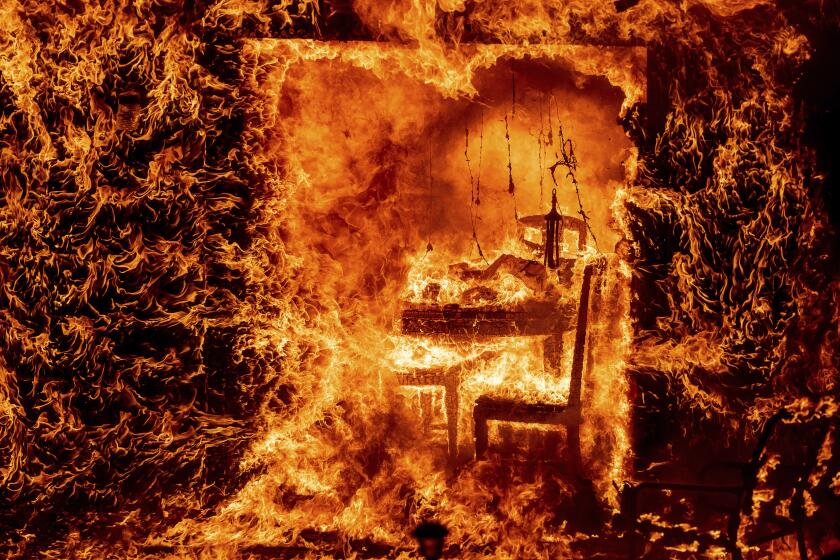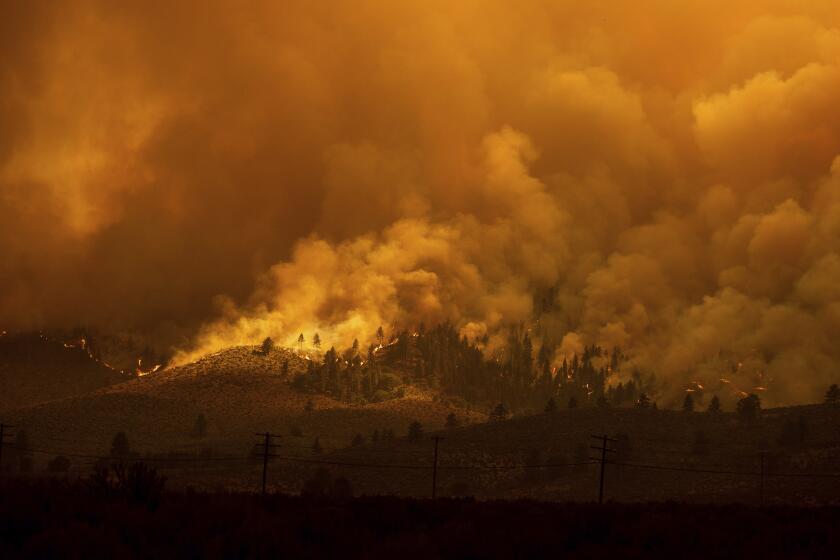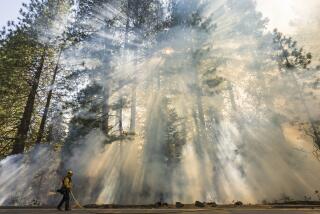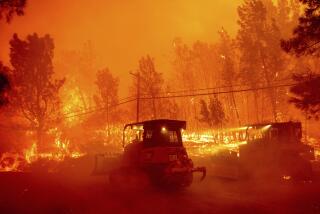Oak Fire near Yosemite rages, threatening mountain communities. âItâs pretty devastatingâ
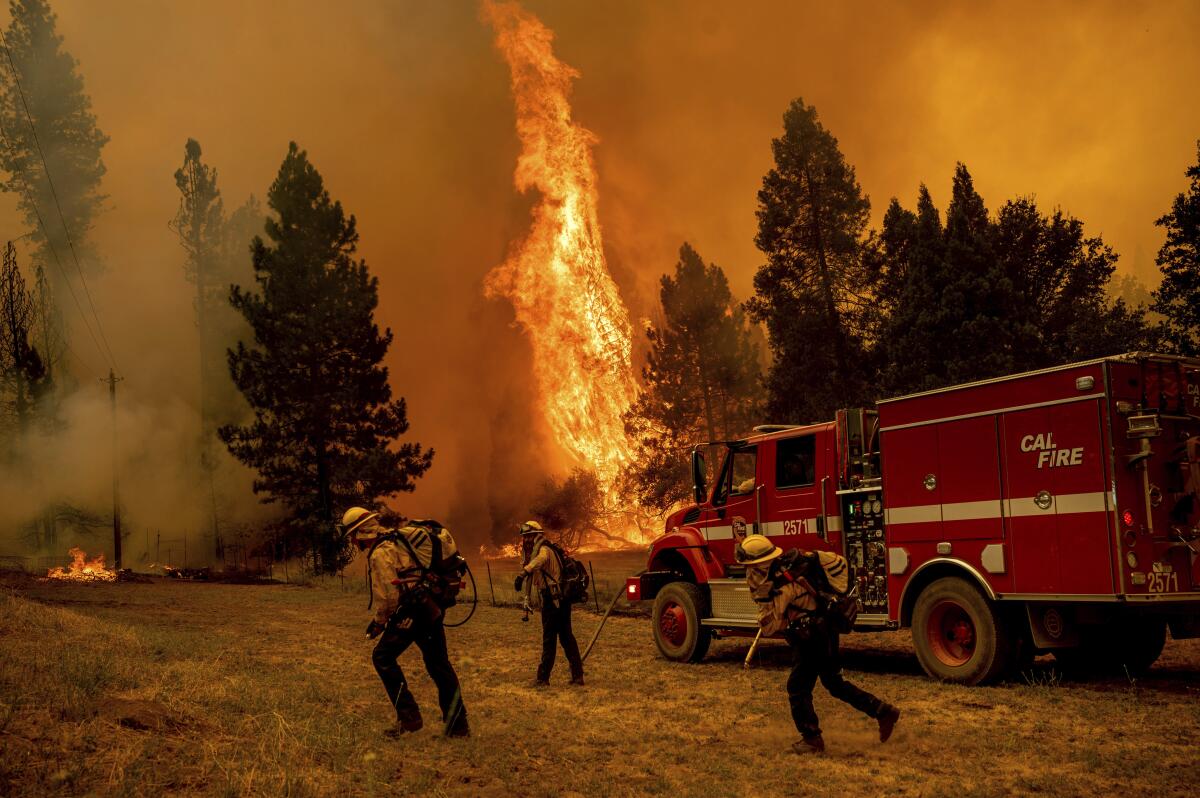
A combination of heat, low humidity and parched vegetation continues to bedevil firefighters battling an inferno in the Sierra Nevada foothills near Yosemite that has forced thousands to flee their homes.
The Oak fire started Friday near Midpines and had grown to more than 15,600 acres as of Sunday evening, making it Californiaâs largest blaze so far this season and prompting Gov. Gavin Newsom to declare a state of emergency for Mariposa County.
Although not as large or destructive as the August Complex fire in 2020 or the Dixie fire in 2021, experts worry the Oak fire is the start to what could be a particularly difficult wildfire season in California.
As the sun rose over the Sierra Nevada foothills, it appeared burnt orange through hazy skies in Mariposa County.
A combination of climate change, intense drought and overgrown vegetation over the last several decades has increased the likelihood of devastating, fast-moving fires.
âI think we can expect much more of the same, unfortunately,â said Park Williams, an associate professor and climate scientist at UCLA. âAs long as we have more heat waves then we will continue to see forests in California really primed to burn because itâs just been so dry.â
The dryness of the vegetation, primed by both long-term drought and shorter-term heat waves, is making it easy for fires to ignite and even easier for them to spread.
Temperatures in the mid-90s â slightly warmer than usual â and single-digit humidity have created a punishing situation for crews battling the Oak fire.
The blaze has destroyed 10 structures, damaged five and is threatening more than 2,600 others, according to the California Department of Forestry and Fire Protection. The fire has forced more than 3,000 residents to flee their homes. Officials have not determined what caused the fire.
Smoke billowing from the blaze choked much of the San Joaquin Valley over the weekend as the fire continued to creep northeast toward the mountain community of Jerseydale and south toward Bootjack.
The plumes of smoke were so thick Sunday morning that they were blowing into Bootjack Market & Deli, about a quarter-mile from the blaze.
Keisha McGruder, who manages the deli just off Highway 49, said sheâs staying open in spite of the conditions to make sure people get food and supplies they need to either hunker down or flee.
That group includes the crew of firefighters and emergency personnel that McGruder is offering free coffee and soft drinks while they turn her parking lot into a impromptu meeting spot.
âItâs pretty devastating up here,â she said.
Since Friday the fire has quickly chewed through parched grass, brush, woodland oak and has moved into timber stands. There flames have overtaken conifers killed by drought and bark beetle infestations causing crown fires, where the blaze burns through the top layer of foliage on a tree.
The heavy fuel load and wind, created by the fire itself, have sent embers casting more than a mile from the blaze, said Hector Vasquez, a spokesperson for Cal Fire.
Despite lackluster weather conditions, resources have been plentiful. More than 2,000 firefighters were battling the blaze Sunday, up from about 500 a day earlier.
âOne of the biggest contributing factors is that we are the only big fight going on right now so we can attract those resources to come in from all over the state,â Vasquez said.
While daytime temperatures are likely to hover in the 90s this week, overnight humidity is expected to improve as monsoonal moisture moves into the region from northern Mexico on Tuesday, said Jeff Barlow, lead forecaster with the National Weather Service.
âDaytime is tough because the fuel is so heavy with tons of dead trees and the fire is kind of almost creating its own weather environment,â Barlow said. âItâs overnight when the fires lay down where weâll be able to see some better overnight recovery.â
Air quality officials predicted the relentless smoke would travel as far as the Bay Area early Monday.

Red Cross officials had checked in more than 100 people at the main evacuation center at Mariposa Elementary School as of early Sunday afternoon.
A little less than half stayed overnight in cots in converted classrooms, said local Red Cross spokesperson Taylor Poisall.
Aubrey Brown and his wife, Lynda, have been at the center since Friday when they rushed from their home in the Lushmeadows community.
Brown was working in his garage when he noticed the sky turning orange. He walked outside to see a giant smoke plume encircling their home.
The couple, both 70, moved from the Bay Area a year and a half ago, enticed by a countryside that reminded them of their youth in more rural areas.
They bought a two-acre property with a custom home with a glass wall that offers sweeping views of the mountains. They understood they were buying into an area prone to fire.
âWe bought with our eyes wide open,â Lynda Brown said. âThereâs a price you pay for having paradise these days.â
Sitting in her front yard Sunday morning while ash rained down on her, Beth Pratt was thankful that things werenât worse.
Less than a mile from the evacuation zone in Midpines, Pratt had packed up her car on Saturday ready to leave.
âThe fire blew up,â said Pratt, 53, who is the California regional executive director for the National Wildlife Federation. âIt looked like Godzilla over my house.â
But then firefighting jets began to arrive dumping retardant and tamping down the flames near her. Pratt cheered them from the ground. The planes havenât stopped coming.
âHere I am in the middle of nowhere outside Yosemite,â she said. âBut I feel like Iâve been under LAX the last couple of days.â
In the 25 years sheâs lived in Midpines, sheâs had to evacuate three times due to wildfires. But she said the Oak fire has been her scariest experience because itâs so large and fast moving.
Sheâs been without power in the sweltering temperatures, hauling up water for herself, five dogs, two cats and a lizard.
Pratt is planning to stay until thereâs an evacuation order because leaving is stressful on her animals, and because once you leave itâs hard to get back, she said.
âIâm still not out of the woods,â Pratt said. âThe wind is blowing the fire away from me. But that means itâs blowing it to someone else which doesnât make you feel good.â
More to Read
Sign up for Essential California
The most important California stories and recommendations in your inbox every morning.
You may occasionally receive promotional content from the Los Angeles Times.
